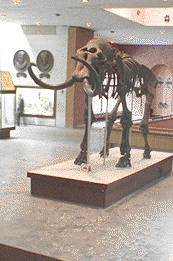UCMP Special Exhibit:
Take a tour of the world's largest paleontological institute, including
Pleistocene mammals from Russia. |
|

This mammoth, found in deposits in Russia, was one of the largest land mammals of the Pleistocene, the time period that spanned from 1.8 million to ~10,000 years ago. Pleistocene biotas were extremely close to modern ones — many genera and even species of Pleistocene conifers, mosses, flowering plants, insects, mollusks, birds, mammals, and others survive to this day. Yet the Pleistocene was also characterized by the presence of distinctive large land mammals and birds. Mammoths and their cousins the mastodons, longhorned bison, sabre-toothed cats, giant ground sloths, and many other large mammals characterized Pleistocene habitats in North America, Asia, and Europe. Native horses and camels galloped across the plains of North America. Great teratorn birds with 25-foot wingspans stalked prey. Around the end of the Pleistocene, all these creatures went extinct (the horses living in North America today are all descendants of animals brought from Europe in historic times).
It was during the Pleistocene that the most recent episodes of global cooling, or ice ages, took place. Much of the world's temperate zones were alternately covered by glaciers during cool periods and uncovered during the warmer interglacial periods when the glaciers retreated. Did this cause the Pleistocene extinctions? It doesn't seem likely; the large mammals of the Pleistocene weathered several climate shifts.
The Pleistocene also saw the evolution and expansion of our own species, Homo sapiens, and by the close of the Pleistocene, humans had spread through most of the world. According to a controversial theory, first proposed in the 1960s, human hunting around the close of the Pleistocene caused or contributed to the extinction of many of the Pleistocene large mammals. It is true that the extinction of large animals on different continents appears to correlate with the arrival of humans, but questions remain as to whether early human hunters were sufficiently numerous and technologically advanced to wipe out whole species. It has also been hypothesized that some disease wiped out species after species in the Pleistocene. The issue remains unsolved; perhaps the real cause of the Pleistocene extinction was a combination of these factors.
Many paleontologists study Pleistocene fossils in order to understand the climates of the past. The Pleistocene was not only a time during which climates and temperatures shifted dramatically; Pleistocene fossils are often abundant, well-preserved, and can be dated very precisely. Some, such as diatoms, foraminifera, and plant pollen, are both abundant and highly informative about paleoclimates. Today, there is concern about future climate change (e.g. global warming) and how it will affect us. Paleontologists who work on Pleistocene fossils are providing a growing amount of data on the effect of climate change on the Earth's biota, making it possible to understand the effects of future climate change.
UCMP Special Exhibit:
Take a tour of the world's largest paleontological institute, including
Pleistocene mammals from Russia. |
|
If you would like to meet some of the large mammals of the Pleistocene, try the following exhibits on our server:
Try these sites for more on the Pleistocene and its critters:


